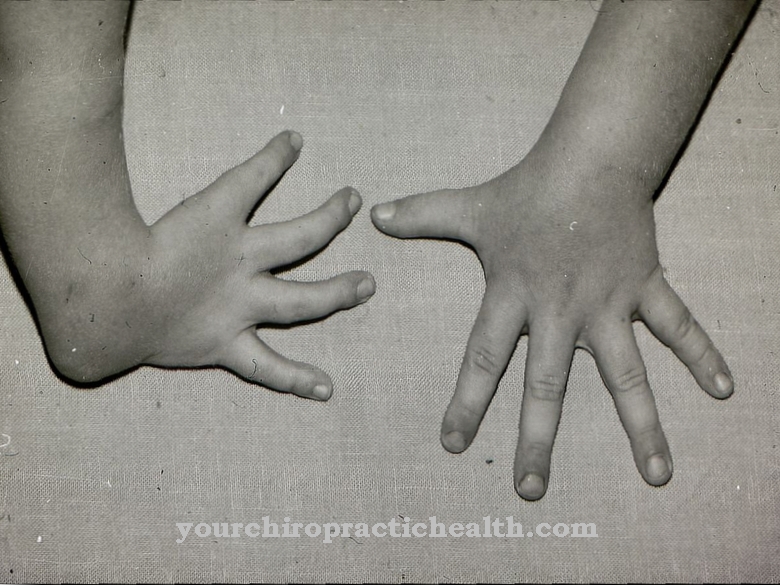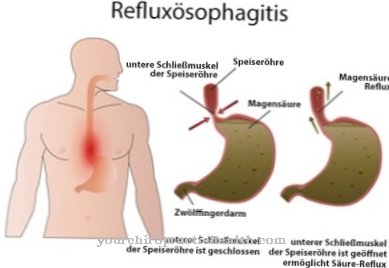Diabetes insipidus is associated with increased urine output and constant feeling of thirst. The chances of recovery depend on how the syndrome is manifested. Because 2 types characterize the classification of diabetes insipidus.
What is Diabetes Insipidus?
.jpg)
© Giuseppe Porzani - stock.adobe.com
Diabetes insipidus (diabainein, Greek: flow through, insipidus, Latin: bland, tasteless) is in German as Water clock known. Despite the same main term, diabetes insipidus has only symptoms similar to diabetes mellitus, which is referred to as diabetes.
In diabetes insipidus, the regulation of the water balance is disturbed. The body excretes too much water, so that the patient is constantly thirsty and has to drink a lot. Nevertheless, there is a constant risk of dehydration. Diabetes insipidus comes in two forms. The more common type is diabetes insipidus centralis, in which the hormone vasopressin is not or insufficiently produced in the brain.
This messenger substance curbs the excretion of water in the kidneys. In diabetes insipidus renalis (renalis, Latin: relating to the kidney), the kidney does not respond to vasopressin. Both forms of diabetes insipidus are characterized by increased water excretion.
causes
Diabetes insipidus can have two different causes according to its two forms. In diabetes insipidus centralis there is damage to the hypothalamus. This is a region of the brain that is located above the pituitary gland and produces a large number of hormones.
Various diseases can affect the nervous tissue of the central core area, so that it can no longer perform its function adequately. Tumors and circulatory disorders as well as strokes or meningitis are the most common underlying diseases that trigger diabetes insipidus.
Very rarely does this subtype appear to be genetic. Diabetes insipidus renalis results from diseases that damage the kidneys. Often this is poisoning, including side effects of medication, but also kidney inflammation or high blood pressure. Severe pregnancies are also a possible cause of renal diabetes insipidus.
Symptoms, ailments & signs
With diabetes insipidus there are a number of different complaints, all of which, however, have a very negative effect on the quality of life of the person affected and usually also make the patient's everyday life significantly more difficult. If the disease is not treated, it often leads to a severe lack of fluids and thus to dehydration.
Deficiency symptoms can also occur, which generally have a very negative effect on the health of the person concerned. The patients suffer from increased thirst and have to go to the toilet more often. When urinating, it can also lead to burning or stabbing pain.
In some cases the thirst of the person concerned is so strong that it can lead to sleep problems and thus to irritability or other psychological upsets. The day-to-day work of the person concerned often suffers considerably from the illness, which can also lead to social complaints.
Patients' skin is often dry and flaky. Diabetes insipidus can also lead to constipation or diarrhea. As a rule, the disease can be limited so that the life expectancy of the person affected is not reduced.
Diagnosis & course
Diabetes insipidus manifests itself as a feeling of intense thirst. If this symptom is present, the doctor will first want to rule out diabetes mellitus by measuring the blood sugar. Because these two very different diseases have this sign in common.
If the blood sugar is in the normal range, the doctor tries to reveal diabetes insipidus with a water balance. Fluid intake and urine excretion are precisely determined. In parallel, the doctor will do blood and urine tests twice a day. If the urine is diluted and the mineral concentration in the blood is increased at the same time, the diagnosis of diabetes insipidus is confirmed.
To differentiate the two variants of the clinical picture, the patient is now given the hormone vasopressin medically. If the symptoms then disappear, diabetes insipidus centralis is present. If the body does not react, the patient suffers from diabetes insipidus renalis. The first form is easily treatable, but renal diabetes insipidus is more complicated and prone to complications.
Complications
Due to diabetes insipidus, the patient suffers from a greatly increased excretion of urine, which in extreme cases can be up to 25 liters per day. The patient's everyday life is severely restricted and in many cases psychological complaints and depression occur. The affected person also suffers from an increased sensation of thirst, although many affected people try to reduce their fluid intake.
It also leads to insomnia and cramps. The patient's quality of life is greatly reduced. Small children in particular can suffer from severe symptoms and consequential damage if the body suffers from persistent dehydration. In most cases, the treatment of diabetes insipidus is causal and depends on the underlying disease.
Often the symptoms can be reduced with the help of medication and they regress. There are no further complications for the patient. If the disease occurs as a result of a tumor, it can either be surgically removed or irradiated.
The further course depends heavily on the spread and type of tumor. In most cases, however, the disease progresses positively and the patient's life expectancy is not restricted.
When should you go to the doctor?
As a rarely occurring form of diabetes, diabetes insipidus can be recognized by an unusually high amount of urine per day. Anyone who secretes three to twenty or more liters of urine daily without ingesting appropriate amounts of fluid should definitely see a doctor.
The doctor must first determine whether one of the two forms of diabetes insipidus is the cause of the unusually high urine output. A tumor in the hypothalamus or pituitary gland may be the trigger for the unusual symptoms. Kidney diseases, the consequences of operations on the brain or other trauma can also be the cause of diabetes insipidus.
The next step is to treat any sequelae of diabetes insipidus. Above all, the attending physician must remedy the hormone deficiency that was probably the cause of the disease. In addition, as a result of polyuria, there may already be a disturbance in the electrolyte balance as well as dehydration.
Since the disorders in diabetes insipidus are serious, self-treatment or reducing the drink dose is the wrong choice. Without medical help, such a large amount of urine and all subsequent consequences can be fatal. Without rapid diagnosis and cause-related or symptomatic treatment, no patient can survive diabetes insipidus unscathed. The water balance must remain in balance because it is essential for survival.
Doctors & therapists in your area
Treatment & Therapy
Diabetes insipidus requires a correction of the mineral balance in the blood as the first immediate measure. Further therapy depends on the type of disease. In the case of diabetes insipidus centralis, drug administration of artificial vasopressin helps purely symptomatically. Another possibility are drugs that can stimulate the secretion of vasopressin in the brain.
The patient should always be careful not to drink too much. The doctor must also clarify what the damage to the hypothalamus is. If a brain tumor is present, the surgeon has to remove it and the patient has to undergo chemotherapy.
The treatment of diabetes insipidus renalis starts with the mineral balance. So the doctor endeavors to lower the blood concentration of sodium and calcium. The key here is a low-sodium diet. Some diuretic drugs (thiazide diuretics) indirectly reduce the excretion of pure water. This happens when the kidneys release more sodium, which means that water is retained in the body.
The damaged kidneys receive additional support from a low-protein diet. It is gentle on the organ and can, but only in minor cases, restore the impaired function. The package of measures maintains an unstable balance between water and minerals. Therefore, the patient has to check his weight regularly, because incorrect settings are a consequence of the therapy for renal diabetes insipidus.
Outlook & forecast
The prognosis of diabetes insipidus depends on the underlying disease. But in general it's good. In some cases a complete cure is even possible. This is particularly the case if the cause of diabetes insipidus is, among other things, elevated calcium levels that are caused by certain drugs or brain tumors. By discontinuing the appropriate medication or successfully treating the tumor, the resulting diabetes insipidus disappears completely.
Although some forms of diabetes insipidus cannot be cured, they can be managed with hormone replacement therapy with desmopressin. With a well-adjusted therapy, people with a hereditary or chronic deficiency in vasopressin can lead a completely normal life. With this therapy, however, it is also important to restrict the intake of fluids, as otherwise the body can even become overhydrated.
Without treatment, diabetes insipidus can lead to death due to dehydration (desiccosis) because the body loses up to 25 liters of fluid per day by excreting large amounts of urine. Even drinking large amounts of water alone cannot stop fluid loss. An agonizing need to urinate and a strong feeling of thirst also lead to sleep disorders, which in turn promote the development of mental illness. In addition to the direct consequences of diabetes insipidus, the underlying diseases also determine the further course.
prevention
Preventing diabetes insipidus means preventing high blood pressure and arteriosclerosis in advance. The general requirements for this are identical to the prophylaxis of cardiovascular diseases. However, this can only influence a few factors that promote diabetes insipidus. Man cannot arm himself against most of the causes of the water level. Of course, preventive medical checkups for early diagnosis of this disease are also useful. Because the sooner the treatment starts, the better the chances of recovery from diabetes insipidus.
Aftercare
With diabetes insipidus, the patient is primarily dependent on early detection of the disease so that further complications and complaints can be prevented. The earlier the disease is recognized, the better the further course of the disease is usually. The follow-up measures are based on the precise underlying disease of diabetes insipidus, so that no general prediction can be made.
In general, with this disease, the patient should follow a healthy lifestyle with a healthy diet. Very sweet or very fatty foods should be avoided in order not to aggravate the symptoms. Sports activities can also have a positive effect on the further course of diabetes insipidus. The treatment itself also involves taking certain supplements that bring the body's mineral balance back into order.
You should always consult your doctor. Accumulations of water in the body should also be regularly examined in diabetes insipidus and treated by a doctor. It also makes sense to get in touch with other people affected, as it is not uncommon for information to be exchanged. Whether the disease will lead to a reduction in life expectancy cannot be universally predicted.
You can do that yourself
Diabetes insipidus, also known as urinary urgency, has nothing to do with type 2 or type 1 diabetes mellitus (diabetes). The main symptom is a pathologically increased excretion of water via the kidneys and leads to a constant feeling of thirst.
The excessive fluid excretion leads to a disturbed electrolyte balance, which can result in considerable secondary damage. Everyday behavior should be geared towards balancing the electrolyte balance and include measures that are suitable for the prevention of arteriosclerosis and high blood pressure. A lowering of the sodium and calcium concentration in the blood has a supporting effect, so that an extremely low-salt diet is recommended.
In parallel to the above measures and the above self-help, it should be medically clarified what the causes of the urinary urgency are. For example, a space-consuming brain tumor can affect the body's control hormones, the hypothalamus and pituitary glands, causing insufficient vasopressin to be produced in the tiny glands to stop the excessive production of urine. Depending on the diagnosis, immediate medical treatment or surgery to avoid a critical course of the disease is urgently necessary.
Those affected who often wake up at night because of a frequent urge to urinate and have little chance of staying asleep should be particularly vigilant during the day, as their ability to concentrate and alertness is often impaired by daytime sleepiness. Driving a car in particular requires careful attention and frequent breaks in order to prevent dangerous microsleep.






.jpg)

















.jpg)



